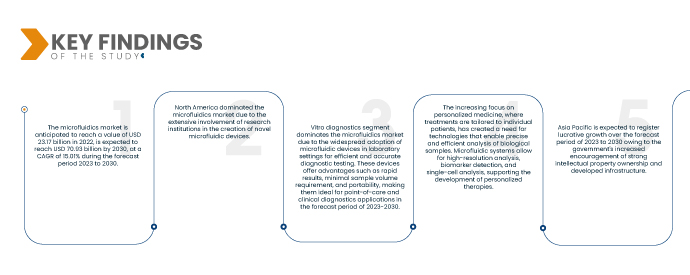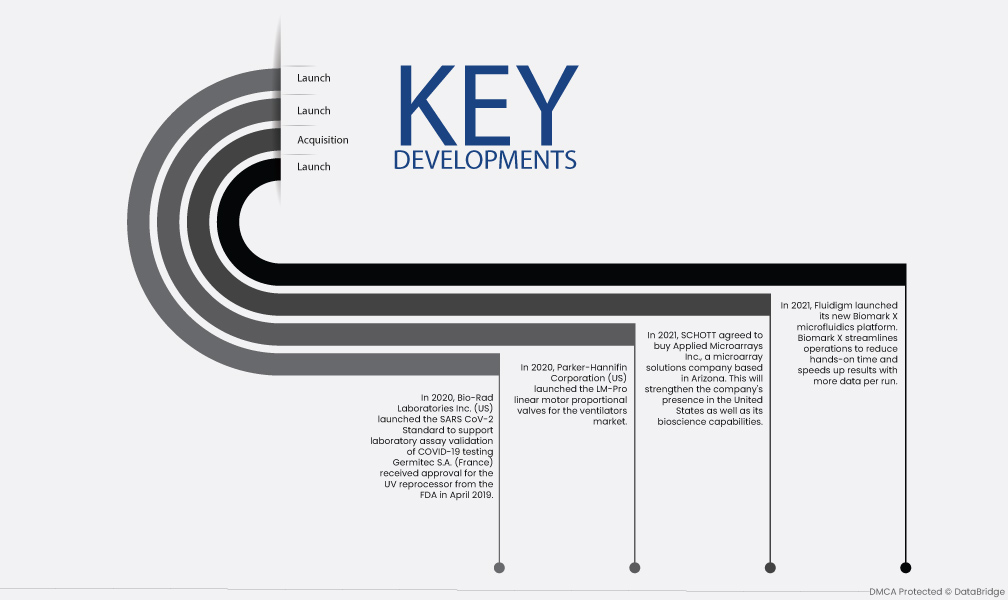Microfluidics technology finds extensive use in various applications across industries. In healthcare, it is utilized for in vitro diagnostics, point-of-care testing, clinical diagnostics, drug delivery systems, and pharmaceutical research. In the industrial sector, microfluidics is applied in environmental research, analytical testing, and high-throughput screening. Additionally, microfluidics plays a crucial role in academic and research institutes for lab analytics, micro dispensing, micro reaction, and laboratory testing. The precise control and manipulation of fluids at the microscale enable innovative solutions for advanced diagnostics, efficient drug discovery, and the development of miniaturized analytical devices.
Access Full Report: https://www.databridgemarketresearch.com/reports/global-microfluidics-market
Data Bridge Market Research analyses that the Global Microfluidics Market is expected to grow to USD 23.17 billion in 2022, and is expected to reach USD 70.93 billion by 2030, at a CAGR of 15.01% during the forecast period 2023 to 2030. Lab-on-a-chip devices, which integrate multiple laboratory functions onto a single chip, are gaining popularity in various industries. The ability to perform multiple analyses simultaneously, reduce sample and reagent consumption, and increase automation has fueled the demand for microfluidic-based lab-on-a-chip devices.
Key Findings of the Study
Microfluidic chip commercialization is expected to drive the market's growth rate
The commercialization of microfluidic chips and platforms by key market players has significantly impacted the growth of the microfluidics market. These companies are actively investing in research and development efforts to enhance the functionality and performance of microfluidic devices. They are expanding their product portfolios to cater to diverse application areas and are forming strategic partnerships with academic institutions and research organizations to promote collaboration and accelerate the adoption of microfluidics in areas such as diagnostics, life sciences, and personalized medicine.
Report Scope and Market Segmentation
|
Report Metric
|
Details
|
|
Forecast Period
|
2023 to 2030
|
|
Base Year
|
2022
|
|
Historic Years
|
2021 (Customizable to 2015-2020)
|
|
Quantitative Units
|
Revenue in USD Billion, Volumes in Units, Pricing in USD
|
|
Segments Covered
|
Product Type (Microfluidic-based devices and Microfluidic Components), Material (Polymer, Glass, Silicon, Metal, Ceramics, PDMS, Other), Technology (Medical/Healthcare, Non-medical), Application (In Vitro diagnostics, Point-of-Care Testing, Clinical Diagnostics, Pharmaceutical Research, Lab Analytics, Microdispensing, Microreaction, Drug Delivery, Laboratory Testing, Analytical Testing, High Throughput Screening), Sector (Industrial, Healthcare, In-vitro Diagnostics, Environmental Research, Clinical Diagnostics), End User (Hospitals and Diagnostic Centers, Academic and Research Institutes, Pharmaceutical and Biotechnology Companies)
|
|
Countries Covered
|
U.S., Canada and Mexico in North America, Germany, France, U.K., Netherlands, Switzerland, Belgium, Russia, Italy, Spain, Turkey, Rest of Europe in Europe, China, Japan, India, South Korea, Singapore, Malaysia, Australia, Thailand, Indonesia, Philippines, Rest of Asia-Pacific (APAC) in the Asia-Pacific (APAC), Saudi Arabia, U.A.E, South Africa, Egypt, Israel, Rest of Middle East and Africa (MEA) as a part of Middle East and Africa (MEA), Brazil, Argentina and Rest of South America as part of South America.
|
|
Market Players Covered
|
Danaher (U.S.), Thermo Fisher Scientific Inc. (U.S.), PerkinElmer Inc. (U.S.), Agilent Technologies Inc. (U.S.), Bio-Rad Laboratories Inc. (U.S.), BD (U.S.), Illumina, Inc. (U.S.), F. Hoffmann-La Roche (Switzerland), Fluidigm Corporation (U.S.), Dolomite Microfluidics (U.K.), QIAGEN (Germany) Abbott (U.S.), BIOMÉRIEUX (France), microfluidic ChipShop GmbH (Germany), Elveflow (France), Cellix Bio. (India), Micronit B.V. (Netherlands), PARKER HANNIFIN CORP (U.S.) and Fortive (U.S.)
|
|
Data Points Covered in the Report
|
In addition to the insights on market scenarios such as market value, growth rate, segmentation, geographical coverage, and major players, the market reports curated by the Data Bridge Market Research also include depth expert analysis, patient epidemiology, pipeline analysis, pricing analysis, and regulatory framework.
|
Segment Analysis:
The microfluidics market is segmented on the basis of product type, material, technology, application, sector, and end user.
- On the basis of product type, the microfluidics market is segmented into microfluidic-based devices and microfluidic components. Microfluidic-based devices dominate the market due to their wide range of applications, including medical diagnostics, drug discovery, genomics, and proteomics. These devices integrate multiple functionalities, enabling precise manipulation and analysis of small volumes of fluids in various research and clinical settings in the forecast period of 2023-2030.
In 2023, Microfluidic-based devices dominate the product type segment of the market
In 2023, Microfluidic-based devices dominate the product type segment of the market in the forecast period of 2023-2030 owing to their broad range of uses, such as genomics, proteomics, drug discovery, and medical diagnostics. In a variety of research and clinical settings, these devices' integrated multiple functionalities allow for the precise manipulation and analysis of small volumes of fluids
- On the basis of material, the microfluidics market is segmented into polymer, glass, silicon, metal, ceramics, PDMS, others. The polymer material segment dominates with a CAGR of 18.9% in the microfluidics market due to its advantageous properties such as cost-effectiveness, ease of fabrication, biocompatibility, and compatibility with various microfluidic manufacturing techniques. In terms of technology, the medical/healthcare segment dominates due to the increasing demand for microfluidic devices in diagnostics, drug delivery, and personalized medicine in the forecast period of 2023-2030.
- On the basis of technology, the microfluidics market is segmented into medical/healthcare, and non-medical. The medical/healthcare segment dominates the microfluidics market due to its essential industry focused on promoting and maintaining health, providing diagnosis, treatment, and prevention of diseases. It encompasses various sectors, including hospitals, clinics, pharmaceuticals, medical devices, telemedicine, and research, crucial for human well-being and advancement in healthcare in the forecast period of 2023-2030.
- On the basis of application, the microfluidics market is segmented into in vitro diagnostics, point-of-care testing, clinical diagnostics, pharmaceutical research, lab analytics, micro dispensing, micro reaction, drug delivery, laboratory testing, analytical testing, high throughput screening. The Vitro diagnostics segment dominates the microfluidics market due to the widespread adoption of microfluidic devices in laboratory settings for efficient and accurate diagnostic testing in the forecast period of 2023-2030.
- On the basis of sector, the microfluidics market is segmented into industrial, healthcare, in-vitro diagnostics, environmental research, and clinical diagnostics. The healthcare sector dominates the sector segment of the microfluidics market with a CAGR of 19.0% due to its extensive use in in-vitro diagnostics and clinical diagnostics applications. Microfluidic devices enable rapid and accurate analysis of biological samples, leading to improved patient care and disease management in healthcare settings in the forecast period of 2023-2030.
In 2023, the healthcare sector dominates the sector segment of the microfluidics market
In 2023, the healthcare sector dominates the sector segment of the microfluidics market in the forecast period of 2023-2030 with a CAGR of 19.0% owing to their wide range of applications, which span clinical diagnostics and in-vitro diagnosis as well as drug discovery, genomics, and pr. Microfluidic devices enable quick and precise biological sample analysis in healthcare settings, enhancing patient care and disease management.
- On the basis of end user, the microfluidics market is segmented into hospitals and diagnostic centers, academic and research institutes, pharmaceutical and biotechnology companies. The end user segment of hospitals and diagnostic centers dominates the microfluidics market due to the increasing adoption of microfluidic technologies for diagnostic purposes. Hospitals and diagnostic centers rely on microfluidic devices for efficient and accurate testing, diagnosis, and patient care in the forecast period of 2023-2030.
Major Players
Data Bridge Market Research recognizes the following companies as the major microfluidics market players in microfluidics market are Dolomite Microfluidics (U.K.), QIAGEN (Germany) Abbott (U.S.), BIOMÉRIEUX (France), microfluidic ChipShop GmbH (Germany), Elveflow (France), Cellix Bio. (India), Micronit B.V. (Netherlands), PARKER HANNIFIN CORP (U.S.)
Market Development
- In 2021, Fluidigm launched its new Biomark X microfluidics platform. Biomark X streamlines operations to reduce hands-on time and speeds up results with more data per run.
- In 2021, SCHOTT agreed to buy Applied Microarrays Inc., a microarray solutions company based in Arizona. This will strengthen the company's presence in the United States as well as its bioscience capabilities.
- In 2020, Parker-Hannifin Corporation (US) launched the LM-Pro linear motor proportional valves for the ventilators market.
- In 2020, Bio-Rad Laboratories Inc. (US) launched the SARS CoV-2 Standard to support laboratory assay validation of COVID-19 testing Germitec S.A. (France) received approval for the UV reprocessor from the FDA in April 2019.
Regional Analysis
Geographically, the countries covered in the microfluidics market report are U.S., Canada and Mexico in North America, Germany, France, U.K., Netherlands, Switzerland, Belgium, Russia, Italy, Spain, Turkey, Rest of Europe in Europe, China, Japan, India, South Korea, Singapore, Malaysia, Australia, Thailand, Indonesia, Philippines, Rest of Asia-Pacific (APAC) in the Asia-Pacific (APAC), Saudi Arabia, U.A.E, South Africa, Egypt, Israel, Rest of Middle East and Africa (MEA) as a part of Middle East and Africa (MEA), Brazil, Argentina and Rest of South America as part of South America.
As per Data Bridge Market Research analysis:
North America is the dominant region in the microfluidics market during the forecast period 2023-2030
North America's dominance in the microfluidics market can be attributed to the extensive involvement of research institutions in the region. The presence of renowned universities and research centers facilitates the development of novel microfluidic devices and technologies. These institutions drive innovation, conduct cutting-edge research, and collaborate with industry players to advance the field of microfluidics. Additionally, North America has a well-established healthcare and biotechnology industry, which further fuels the demand for microfluidic technologies in applications such as diagnostics, drug discovery, and genomics.
Asia-Pacific is estimated to be the fastest-growing region in the microfluidics market in the forecast period 2023-2030
Asia-Pacific is expected to experience the highest growth rate in the microfluidics market due to several factors. Governments in the region are increasing their support for the development of infrastructure, research facilities, and technology parks, creating a conducive environment for microfluidics innovation. Furthermore, there is a growing emphasis on intellectual property ownership, encouraging local companies and startups to invest in research and development, leading to the emergence of new microfluidic technologies and applications. These factors, combined with the region's large population and expanding healthcare sector, drive the anticipated growth of the microfluidics market in Asia-Pacific.
For more detailed information about the microfluidics market report, click here – https://www.databridgemarketresearch.com/reports/global-microfluidics-market
















